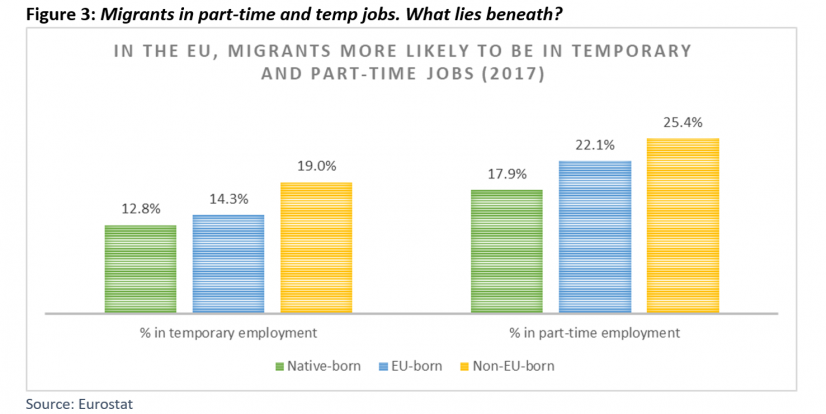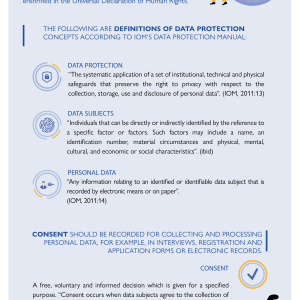The gig economy in numbers: The United States and Europe
But little is known about how gig work helps or hinders immigrant integration, in part because of the difficulties of measuring the gig economy at all. In the United States, currently the country with the best data, a number of disparate figures circulate. The 2017 Contingent Workers Supplement (CWS), an official national survey covering around 60,000 households, found that 1 per cent of the US workforce is engaged in work obtained through websites or mobile apps, while other estimates go as high as 8 per cent.
In Europe, where data are more limited, estimates also vary wildly: the COLLEEM study—the most significant effort so far to measure service provision via platforms across the EU—puts the share of workers who ever performed online-platform work in Germany at 12 per cent, while a survey commissioned by the German government puts it at less than 8 per cent. A lot of this variance simply comes from different definitions of “gig economy”. For instance, the term sometimes describes any non-standard work of an independent and short-term nature, rather than just platform- or app-based work (see figure 1).
The gig economy and integration: what are the challenges and opportunities?
Better understanding the gig economy could help governments adapt tax and social security legislation and rethink education systems. But integration policymakers should also take note. Gig work could soften some of the most stubborn obstacles immigrants and refugees face in host-country labour markets in Europe and elsewhere. For instance, in places like Paris, where second-generation immigrants experience employer discrimination, driving an Uber can be a ticket to financial independence. For refugees sent to rural areas of Scandinavia, where housing is plentiful but the jobs are few, online platforms could provide a valuable lifeline. But gig jobs could equally exacerbate existing challenges, if newcomers are plunged into socially isolated work where they struggle to make ends meet, let alone save for their retirements.
In our report Jobs in 2028: How will changing labour markets affect immigrant integration in Europe?, we explored four different scenarios for future immigrant integration, ranging from the dire (polarisation) to the more hopeful (entrepreneurialism). At worst, the gig economy could push migrants further out to the fringes of our economies and societies: stripped of labour rights and social protection, unable to gain more skills, and locked out of social capital, they would make the ideal scapegoat for social tensions around growing inequalities. At best, gig work could help migrants struggling to set foot into the highly regulated world of traditional employment, while allowing them to connect with a transnational client base—provided that they have the necessary digital and entrepreneurial skills.
The future is not fixed; decisions taken now could help move us towards the better of these scenarios. But better data are needed to provide a framework for these choices.
Moving towards better data
Evidence on migrants’ participation in the gig economy is thin, as most relevant reports do not analyse their data by migration-related indicators. But this could soon change, especially if official labour force statistics get better at mapping new ways of working both on- and offline. Some countries are making headway: in the United States, the 2017 CWS included questions on work mediated by online platforms for the first time. Since the survey also asks about country of birth, citizenship status, and time in the US, it should allow for more in-depth analyses of migrants in the gig economy, as well as on their profiles, experiences and pathways. A taster of what these data are likely to reveal comes from a 2017 study by UC Berkeley, which shows that migrants are overrepresented in the Californian gig economy (figure 2)—more specifically, at its low-wage end.
The EU and its Member States could follow suit and adapt large-scale official surveys to collect data on more fluid forms of work. This would give important context to the current finding that migrants are overrepresented in temporary and part‑time employment (see figure 3). In the meantime, research projects demonstrate a growing interest in understanding migrants’ vulnerabilities to labour markets’ transformation, as well as possible countermeasures. A recent European study found that non-EU migrants are about three times more likely to work in jobs with high automation potential than nationals, but that higher levels of education massively reduce this likelihood.
The European “refugee crisis” also added new urgency to calls for better data. In Germany, the IAB-BAMF-SOEP longitudinal survey, launched in 2015 with the goal to make reception and integration policies more evidence-driven, links data on the living situation of recently arrived refugees with five different national data sources on employment biographies, to gain a more granular understanding of refugees’ occupational pathways. Longitudinal studies like this one may provide a methodological blueprint for further efforts to investigate the link between gig work and immigrant integration.
Lastly, we must keep in mind that some of the most vulnerable categories of gig workers—immigrants with no secured legal status and/or working illegally in the shadow economy—are particularly hard for any survey to cover. To get a full picture of the gig economy which also includes its bleaker sides, filling this gap is key. Researchers may draw lessons from methods specifically developed to survey undocumented immigrants, which often include a stronger element of ethnographic research and fieldwork.
















